Ceramic pizza stones are flat, heat-retaining surfaces designed to replicate the effects of a traditional brick oven, resulting in crispier pizza crusts and evenly cooked pies.
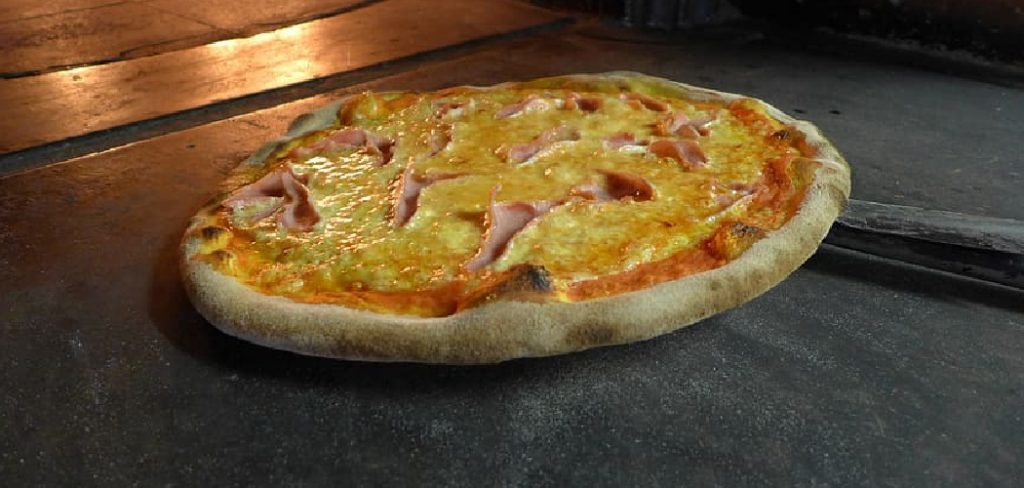
These stones work by distributing heat uniformly across the surface and absorbing excess moisture from the dough, which helps achieve that perfect, authentic texture pizza enthusiasts crave. Whether you’re an experienced home chef or a beginner, using a ceramic pizza stone can elevate your pizza-making experience and deliver professional-quality results right in your kitchen.
This guide will walk you through how to use ceramic pizza stone efficiently. From preheating the stone to properly building and transferring your pizza, each step is crucial to achieving the best possible outcome. We’ll also cover important tips on caring for and cleaning your stone to maintain its durability and performance over time. With this knowledge, you can start mastering pizzas that rival your favorite pizzerias.
What Is a Ceramic Pizza Stone?
A ceramic pizza stone is a cooking tool designed to help you achieve evenly cooked, crispy pizzas that mimic the results of a professional brick oven. Made from porous ceramic material, it works by absorbing moisture from the dough and distributing heat uniformly across the surface. This process ensures a perfectly baked crust with just the right balance of crunch and softness.
Composition and Design
Ceramic pizza stones are crafted from durable, heat-resistant materials that perform well under high temperatures. The porous nature of the ceramic allows it to draw moisture from the pizza crust, which helps prevent sogginess. Additionally, the even heat distribution of the stone ensures consistent cooking, eliminating the risk of cold spots or unevenly baked edges.
How It Works
When preheated, the stone retains and radiates heat effectively, creating an environment similar to a brick oven. This high, consistent heat is key to achieving a crisp bottom crust and evenly melted toppings. By placing your pizza on a properly heated ceramic stone, you can replicate the results of traditional pizzeria ovens in your home kitchen.
Types of Ceramic Pizza Stones
Ceramic pizza stones come in a variety of shapes and sizes to suit different needs. Round, square, and rectangular designs cater to different oven types and pizza styles. Thicker stones offer superior heat retention, allowing for longer cooking times and better results with dense or heavily topped pizzas. Whatever shape and size you choose, a ceramic pizza stone is an essential tool for any pizza enthusiast.
Preparing the Pizza Stone
Preheating
To achieve optimal results, proper preheating of your ceramic pizza stone is essential. Begin by placing the stone in a cold oven to prevent sudden temperature changes that could cause cracking. Preheat the oven to a temperature between 450°F and 500°F, depending on your recipe. Allow the stone to heat for at least 30–45 minutes to ensure it reaches the ideal temperature for cooking. A fully heated stone is key to producing a perfectly crispy crust.
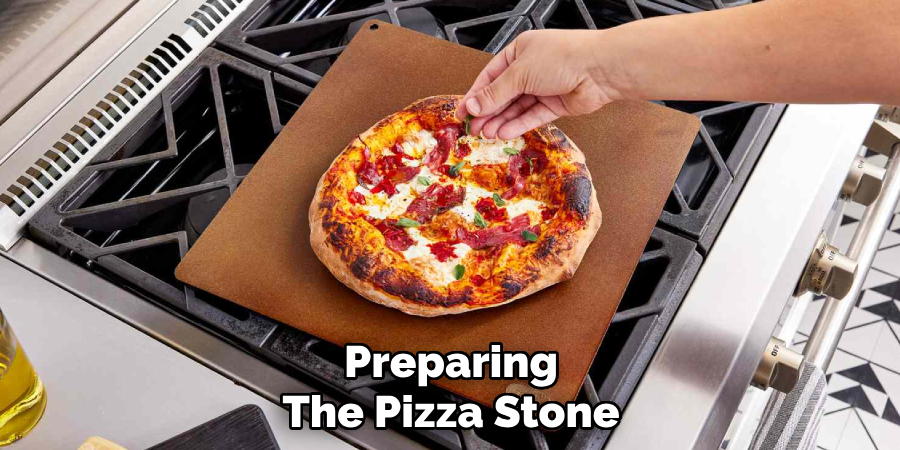
Avoiding Thermal Shock
It’s essential to handle your pizza stone carefully to prevent thermal shock, which can cause irreparable damage. Never place a cold stone into a hot oven or attempt to cook cold or frozen pizza directly on a warm stone. Such sudden shifts in temperature can cause the ceramic material to crack or warp. Always allow your stone to heat and cool with your oven gradually.
Optional Tip: Place the Stone on the Middle Rack
For optimal heat distribution, consider positioning your ceramic pizza stone on the middle rack of your oven. This placement helps balance the heat exposure, ensuring even cooking of your pizza crust and toppings. Following these steps will help you enjoy consistently delicious results every time you use your pizza stone.
How to Use Ceramic Pizza Stone: Making and Placing Your Pizza
Building Your Pizza
Start by preparing your pizza dough on a pizza peel or a sheet of parchment paper. This setup makes it easier to transfer the pizza to your preheated ceramic stone. When building your pizza, aim for balance—use a minimal amount of sauce to avoid excess moisture that can lead to a soggy crust. Limit the toppings as well, since overcrowding the pizza can prevent even cooking and make the crust less crispy.
Transferring the Pizza
To transfer your pizza to the stone, use a pizza peel dusted with a small amount of cornmeal or flour. The dusting helps the pizza slide smoothly onto the stone. If you’re working with parchment paper, ensure it’s labeled as oven-safe to withstand high temperatures. Simply place the pizza, parchment paper, and all, directly onto the stone.
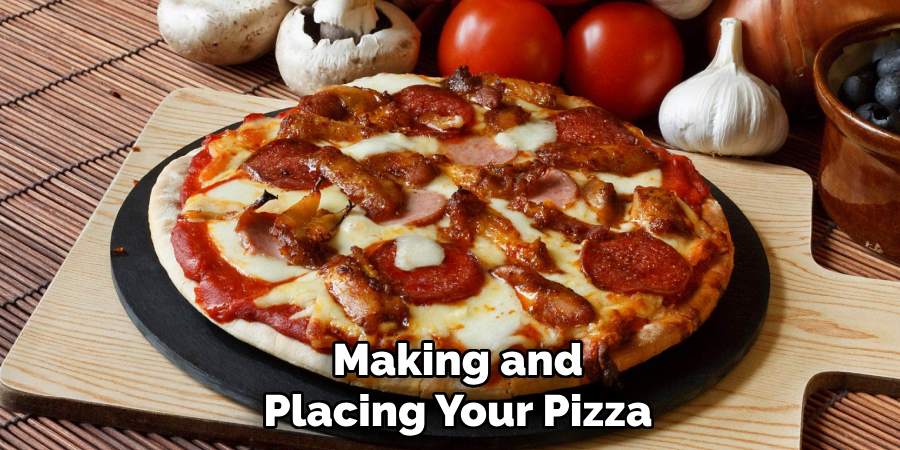
Baking Time and Tips
Bake your pizza for approximately 8 to 15 minutes, depending on your oven’s heat and the thickness of the crust. Keep an eye on the pizza during baking—the cheese should be bubbling, and the crust should achieve a golden-brown color. These visual cues indicate that the pizza is perfectly cooked. For optimal results, refrain from opening the oven too frequently, as this can cause heat loss and result in uneven cooking. With the right preparation and care, you’ll enjoy a mouthwatering pizza with a perfectly crisp crust every time.
Removing the Pizza and Serving
Using a Pizza Peel or Spatula
Once your pizza has finished baking, carefully remove it from the oven. Use a pizza peel or a sturdy spatula for this process. Gently slide the peel or spatula underneath the pizza, ensuring that you support the weight of the crust to avoid any sagging or tearing. If using a pizza stone, take extra care not to scratch its surface. Slowly lift the pizza out of the oven and transfer it to a suitable surface, such as a wooden cutting board or heat-resistant plate.
Let It Cool Slightly
Allow the pizza to rest for a few minutes before slicing. This cooling period not only helps to prevent burns but also allows the cheese and toppings to settle, enhancing the firmness of the slices. Cutting into the pizza too soon can cause the toppings to slide off, disrupting the pizza’s presentation and texture.
Serving Tips
When slicing, always use a cutting board rather than the pizza stone to prevent damage. Use a sharp pizza cutter or large knife to make clean, even cuts. Consider serving the pizza with a side of dipping sauces or garnishes, such as fresh basil leaves or a sprinkling of parmesan, to elevate the flavor experience. Serve immediately and enjoy!
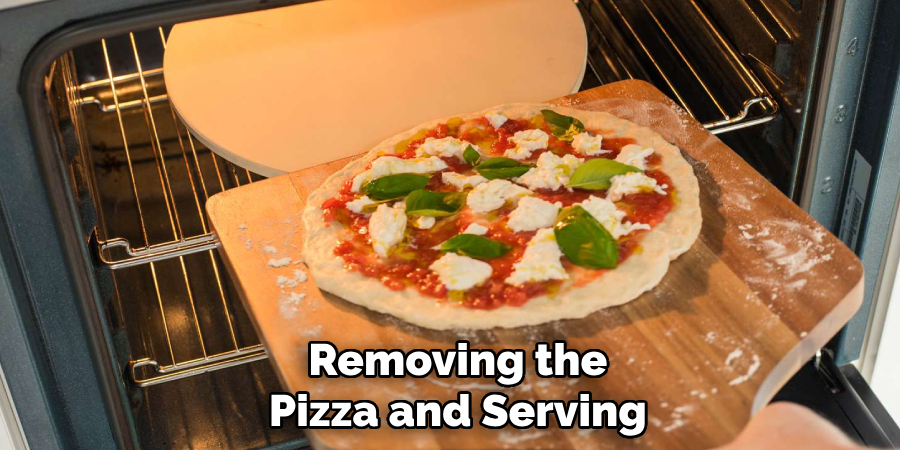
Cleaning and Maintaining Your Ceramic Pizza Stone
Proper care of your ceramic pizza stone ensures it remains functional and lasts for years to come.
Cool the Stone Completely First
After using your pizza stone, allow it to cool completely before cleaning. Never run cool water over a hot stone, as the sudden temperature change can cause it to crack. Patience is key to maintaining its structural integrity.
Cleaning Process
To clean the stone, start by removing any leftover food debris using a damp cloth or a plastic scraper. Avoid the temptation to use soap or detergent, as ceramic is porous and can absorb these cleaning agents, leaving behind an unpleasant taste in future bakes. Warm water and gentle scrubbing are sufficient for most cleaning needs.
Stain Prevention & Longevity Tips
It’s important to note that stains on your pizza stone are entirely normal and don’t impact its performance. However, to prolong the life of your stone, store it in a dry, cool place. Avoid stacking heavy items on top of it to prevent cracking or breakage. Furthermore, refrain from seasoning the stone with oil, as it can cause discoloration and smoke when heated. With proper care and storage, your ceramic pizza stone will remain a reliable companion in creating delectable homemade pizzas.
Common Mistakes to Avoid
Skipping Preheat Time
One of the most common mistakes is skipping the preheating phase. A properly preheated pizza stone ensures even heat distribution, resulting in a perfectly crisp crust. Without sufficient preheat time, your pizza may end up with an undercooked or doughy base. Always allow the stone to heat up fully in the oven before placing your pizza on it.
Using Non-Oven-Safe Paper or Utensils
Avoid placing wax paper or any non-oven-safe materials onto your pizza stone. These can pose a significant fire hazard and may also damage the stone’s surface. Similarly, ensure any utensils, such as spatulas or cutters, are safe for high heat and won’t scratch the stone.
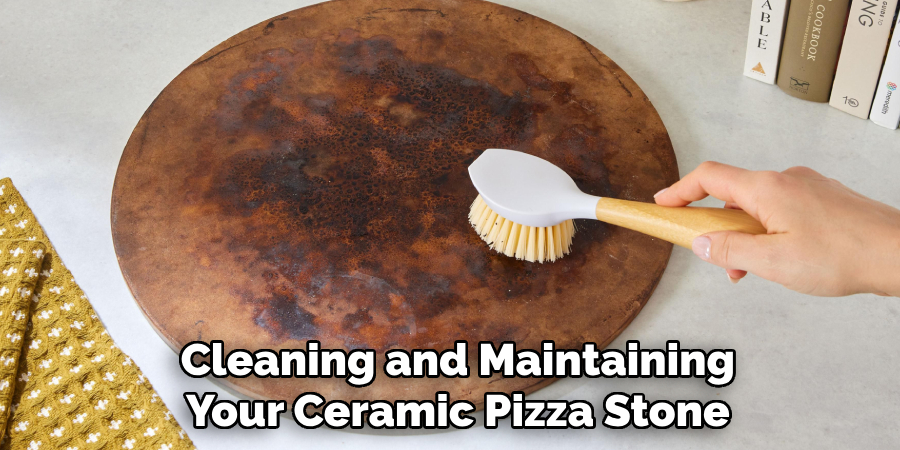
Adding Cold or Wet Items
Placing cold or damp ingredients directly onto a hot pizza stone can lead to rapid temperature fluctuations, which may cause the stone to crack. Furthermore, excess moisture from wet items can lead to soggy pizzas. Always ensure that your toppings are at room temperature and that your ingredients are drained of excess liquid.
Using Abrasive Cleaners
Harsh cleaners or abrasive scrubbers can degrade the ceramic surface of your stone over time. Instead, clean the stone with a plastic scraper and water after it has completely cooled. Proper care will help maintain the surface and ensure your pizza stone lasts for years to come.
Conclusion
Using a ceramic pizza stone enhances homemade pizza by delivering a perfectly crispy crust and evenly baked toppings. To achieve the best results, remember to preheat the stone thoroughly, assemble your pizza carefully to prevent sogginess, transfer it gently to avoid accidents, and clean the stone with non-abrasive tools after it cools.
Understanding “how to use ceramic pizza stone” effectively will ensure you get the most out of this versatile kitchen tool. With a little practice and proper care, your ceramic pizza stone will become an indispensable part of your pizza nights, elevating every slice you bake.
Specialization:
- Master of wheel-throwing, hand-building, and advanced glazing techniques
- Focus on creating both functional pottery and decorative art pieces
Recognition:
- Celebrated by collectors and art enthusiasts for creating one-of-a-kind pieces that blend artistry with functionality
- Participates in local and national exhibitions, earning accolades for his innovative designs and craftsmanship
Passion:
- Deeply committed to exploring and pushing the boundaries of ceramic artistry
- Continuously experiments with new materials, firing techniques, and artistic concepts to evolve his craft
Personal Philosophy:
- Believes in the transformative power of art, aiming to evoke emotions and connections through his ceramic creations
- Advocates for sustainability in ceramics, using eco-friendly materials and practices whenever possible


